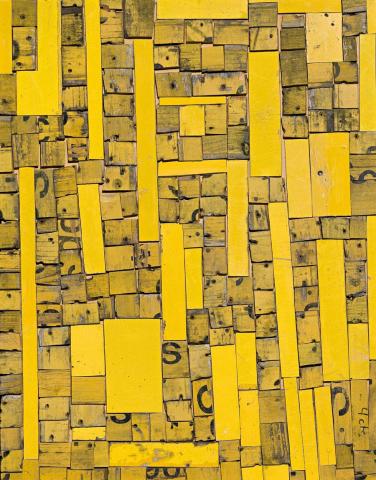GOLD RUSH, 1996
Rosalie Gascoigne
wood and retro-reflective material on wood
76.5 x 60.5 cm
signed, dated and inscribed verso: Rosalie Gascoigne / 1996 / GOLD RUSH
Greenway Art Gallery, Fifth Australian Contemporary Art Fair, Melbourne, 5 October 1996
Private collection, Melbourne
MacDonald, V., Rosalie Gascoigne , Regaro, Sydney, 1998, p. 108
Of all of Rosalie Gascoigne's achievements, undoubtedly the most striking and widely celebrated are her black-on-gold assemblages which incorporate the shimmering text of weathered wooden Schweppes crates or retro-reflective road signs. Discussing the use of the reflective yellow road signs that dazzle so brilliantly in works such as Gold Rush 1996, MacDonald illuminates the artist's discovery of her first cache of 'retro' amidst a road gang's tangled debris: 'She gathered together a sackful of this stuff as a "road-mending kit" for her grandchildren in Tasmania... and stacked the remainder in her courtyard. The yellow signs sat there, forgotten, too bright for her taste: it's pretty hideous when you see it in the flesh; I didn't take much notice of it." Then one day it rained and she saw the gleaming signs anew. "I knew the material, I'd rejected it... then it took me on my blind side."'1
Like the best of her work, Gold Rush does not symbolise the landscape but rather 'represents' it, each fragment of road sign or wood evoking memories and associations particular to the individual viewer. Having eschewed the use of iconography, Gascoigne thus transforms text into texture - a wordplay of which she is no doubt aware - to suggest a powerful sense of landscape and light. With their rhythmic pattern composed of words, such works have not surprisingly been described as 'stammering concrete poems'2 - a perceptive analogy, especially given the artist's predilection for poetry from Shakespeare to Plath. Notwithstanding, Gascoigne stresses that the flickering word fragments, though carefully arranged, are not intended to be read literally: 'Placement of letters is important, but it's not a matter of reading the text - it's a matter of getting a visually pleasing result.'3
Similarly, her titles are not literal but rather, 'leave room for the viewer', imbued with various levels of meaning to be deciphered according to the nature of one's experiences. As John McDonald elucidates, Gascoigne's work '...awakens associations that lie buried beneath the surface of consciousness; inviting a higher degree of sensitivity and attentiveness to the world around us.'4 Indeed, it is this higher awareness, the ability to recognise beauty in the most humble of materials that Gascoigne demands of her audience. For, as the eye moves through this artful arrangement searching for information and the mind attempts to place different rules of perspective or build upon the suggestion of the marks, 'in time we realise that the only solution is to stop trying to navigate through the forest of symbols, and enjoy the beauty of the trees.'5
1. MacDonald, V., Rosalie Gascoigne , Regaro, Sydney, 1998, p. 35
2. Ibid., p. 34
3. Ibid., p. 35
4. Ibid., p. 7
5. Ibid.
VERONICA ANGELATOS
